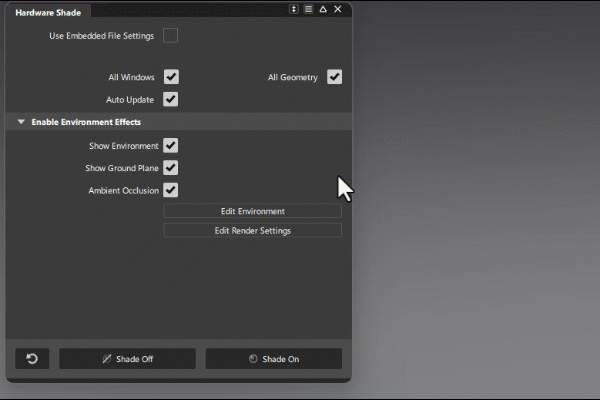VRED Environment Settings
![]()
When you switch to the VRED Renderer and turn on Show Environment, the VRED default dome geometry and defaultEnvironment.hdr display in the scene. Use the VRED-based environment attributes to achieve the desired look of the environment. Access the Environment Settings from the Hardware Shade window.

Environments created in Alias cannot be used in VRED. Therefore, if you are creating a Live Reference between Alias and VRED, you need to recreate the environment in VRED to get a similar look.
Environment Editor icons
![]() - Delete the current environment shader.
- Delete the current environment shader.
![]() - Load an environment shader into the scene.
- Load an environment shader into the scene.
![]() - Save the current environment shader.
- Save the current environment shader.
Environment Material
Environment - Loads the HDR image to be used as the lightsource. The HDR image is used as an environment, which is reflected on reflective surfaces. LDR (.png and .jpg) can also be loaded.
Click
 to locate and assign a texture. When a texture is assigned, the path and filename are displayed in the field to the left.
to locate and assign a texture. When a texture is assigned, the path and filename are displayed in the field to the left.Environment Geometry - Selects the geometrical form for the current environment. Dome, Sphere, and Cube shapes are available as presets.
- Is Visible - Toggles the primary visibility of the environment. An environment material set to not be visible can still illuminate scene objects, if it is enabled to be used as lightsource.
- Flip Inside Out - Flips the normals of the environment sphere. This changes whether the environment geometry can be viewed from the inside or outside.
Shadows and Illumination
- Shadow Lightsources - Sets the number of explicit lightsources. There are 64 lightsources available. Enter a value between 0 and 64, or use the slider to set the value. Use Alt + MMB drag to set values greater than 10.
Use Lightsources Only - When selected, only the shadow lightsources used for the environment are used for illumination. At least one lightsource must be entered in the Shadow Lightsources option for results.
Material Shadow Intensity - Sets the shadow intensity of the generated lightsources on BRDF-based materials.
- Ground Shadow - Sets the shadow intensity of the generated lightsources on the shadow material.
- Map Filter Radius - Sets the radius used for filtering the shadow map.
- Map Resolution - Sets the quality of shadow maps. Higher values increase the quality.
Color Correction
- Exposure - Sets the scaling factor on the HDR results. It controls the influence about lighting and reflection from the environment node to any object within the scene. A threshold from 1.0 interprets the texture exactly like it is; a value below/above darkens/lightens all objects. Set the HDR image’s exposure level. The higher the exposure level, the longer the series of shutter cycles which are used to calculate the image’s light intensity.
- White Balance K - Sets the camera's white balancing color temperature. Lower values balance the camera to a lower color temperature and therefore create cooler (bluish) colors. A higher value balances the camera to a higher color temperature and produces a warmer (yellowish) color. 6500K is a sRGB standard for most monitors.
- Hue-Shift - Shifts all colors in the HDR image uniformly through the hue color range, setting the hue shift in degrees.
- Contrast - Separates the light and dark color values further from each other, setting the color contrast.
- Brightness - Sets the scaling factor that is a part of the color correction, by applying a color correction matrix, raising the color value of the whole HDR image, and setting the color brightness. It is applied to the image before the scaling by the exposure.
- Saturation - Sets the HDR image’s saturation.
- Reflected Saturation - Sets the HDR image’s saturation when the HDR image reflects in any surface.
Environment Geometry Transformation, Environment Material Transformation, and Environment Ground Plane Transformation
Use the transformation settings for translate, rotate, and scale to manipulate the environment geometry, material, and ground plane. MMB-drag the values or select Manipulate and use the transform manipulator to make the required adjustments.
- Translate/Center X, Y, Z - Sets the x, y, and z coordinates for the center of the projection.
- Rotate X, Y, Z - Sets the x, y, and z rotation angles for the projection plane.
- Scale X, Y, Z - Sets the x, y, and z scale factor for the projection plane. With the scale value, the image projection can be stretched and squashed on any axis.
- Manipulate - Activates/Deactivates the interactive environment texture manipulator in the viewport.
